2025-2026 Jones Howler
Test Duration: 18 days
Test Locations: Chugach Mountains & Alyeska Resort, AK
Available Sizes: 152,155, 15W, 158, 160W, 161, 163W
Blister’s Measured Weight (160 W): 3.21 kg / 7.06 lb
Stated Nose-Waist-Tail Widths (160 W): 312-267-304 mm
Stated Sidecut Radius (160 W): 8.6 m
Rocker Profile: “High Power Camber” (traditional camber + rockered nose and tail)
Stated Flex Rating: 4/5
Core Construction: Bamboo, Paulwonia, Poplar
Base: Sintered 8000
Reviewer: 5’11”, 175 lbs / 180 cm, 79 kg
Stance: +25 / 0, 23’’
Boots Used: Nitro Select, K2 Orton, Thirty Two TM-2 XLT, K2 Evasion
Bindings Used: Now O-Drive, Jones Apollo, Jones Mercury FASE, Union Ultra FC
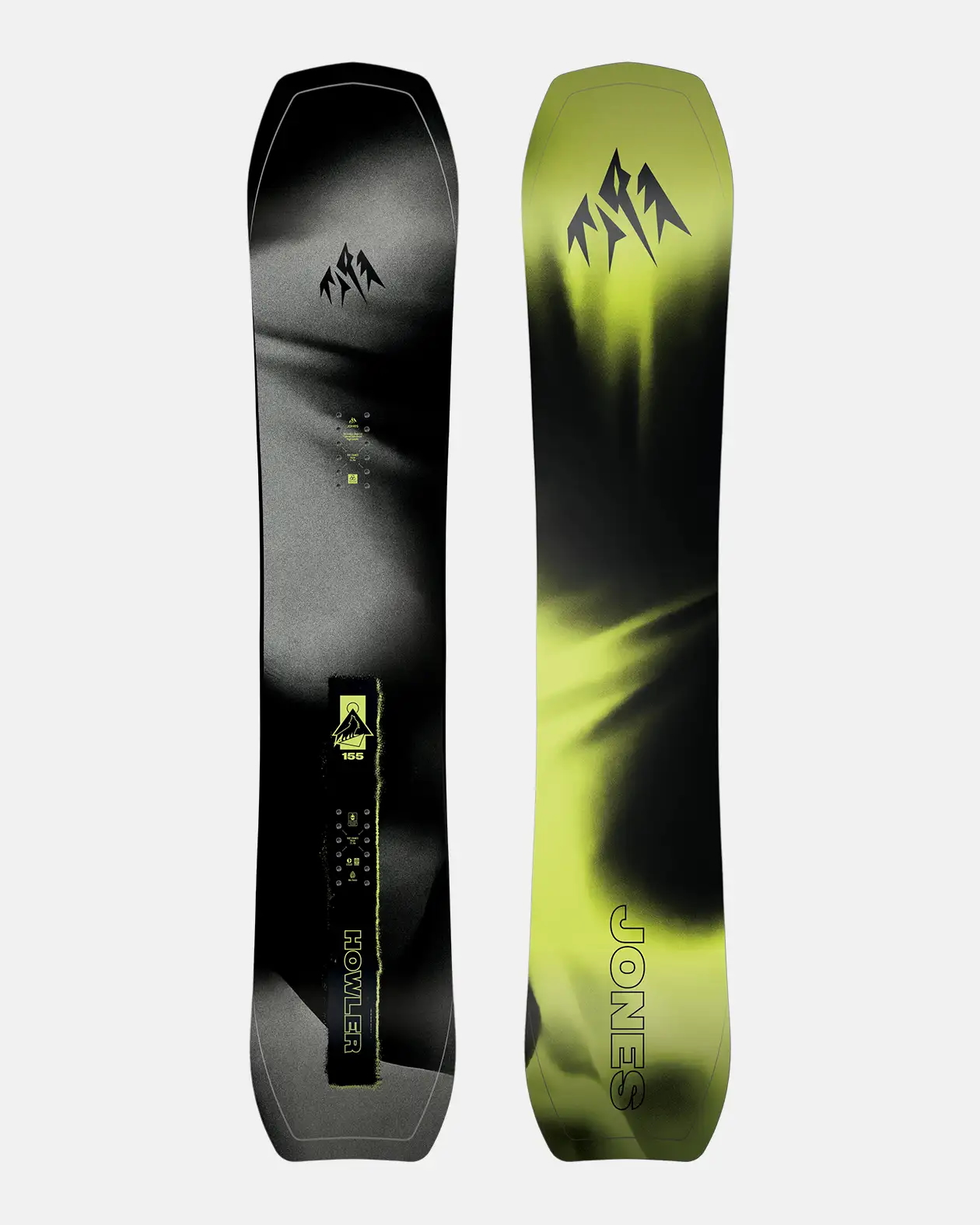
Intro
The Jones Howler was first launched as a limited-edition model in partnership with Jones athletes, Xavier De Le Rue and Elena Hight, during the 24/25 season. This season, it’s cemented its spot within the brand’s lineup as their latest Freeride-focused model. Xavier De Le Rue and Elena Hight were deeply involved in the design of the Howler, blending elements of their Freeride and Freestyle roots into a shape tailored to powder riding and backcountry terrain.
Given that the athletes behind this board blur the lines between riding styles and categories, we were eager to find out where the Howler would slot into the market, and what sorts of non-professional riders it would best suit. So, let’s first dive into the details of the design, and then what we’ve learned throughout our on-snow testing.
What Jones Says about the Howler:
“The Howler is a next level directional Freeride board built for making steep, technical terrain your playground. The minimally tapered directional shape is matched with a hybrid full camber profile that offers insane pop, stability and edge hold. Designed in collaboration with Victor De Le Rue and Elena Hight, the Howler is ready to float down spine lines and stomp huge airs with authority.”

Construction
The Howler’s core is a blend of bamboo, paulownia, and poplar. The central bamboo stringers are intended to increase durability, pop, and torsional stiffness, while the lighter paulownia and poplar sections shave some grams. A Koroyd insert is built into the nose with a goal of reducing swing weight and providing additional damping; Koroyd is an extremely lightweight welded tubular structure that is often found in helmets (and that Jones has been integrating into some of their boards).
Triaxial fiberglass wraps the Howler’s core, and Jones adds carbon / flax stringers positioned in a V shape, extending from the binding inserts outward to the tip and tail, as a means of increasing pop and reducing chatter.
Jones has a history of being very mindful with material selection, prioritizing both sustainability and durability to minimize waste and keep the board in use for as long as possible. The topsheet is derived from castor beans, and it has held up impressively well during my first ~20 days of riding. It also does a decent job of shedding snow and ice buildup.
The Howler is fully wrapped in recycled, oversized (~3mm-thick) edges, along with rounded ABS sidewalls. The board is finished off with a Sintered 8000 base, which Jones claims is fast, absorbs wax well, and is easy to repair. After riding a wide range of spring-like conditions, from frozen groomers to corn, slush, and powder, the base is in great shape and so far seems more durable than that of the Head E.B.I. LYT or United Shapes Deep Reach.
Jones also utilizes a production process they call “Forever Flex,” which seems to help their boards maintain a consistent flex pattern and rocker shape over the board’s lifetime. While I’ve only logged about 20 days on the Howler, I’ve recently spent a couple of seasons on the Jones Storm Wolf and Storm Chaser, which have also undergone this process, and I can report that they still flex and ride pretty similarly to when they were brand new.
The overall weight of the Jones Howler seems consistent with comparable boards from other manufacturers, coming in at 3.21 kg / 7.06 lbs for our 160W size. While weight is more of a concern for me in a splitboard, the Howler strikes me as heavy enough to help it feel damp in choppy conditions, yet it doesn’t take too much effort to throw around when riding or hitting jumps.
For reference, here are our measured weights for the Howler and some other comparable models:
- Weston Gnarnia (162 cm): 2.98 kg / 6.57 lbs
- Arbor Iguchi Pro Camber (162 cm): 3.07 kg / 6.77 lbs
- Nitro Squash (159 cm): 3.09 kg / 6.81 lbs
- Jones Howler (160W cm): 3.21 kg / 7.06 lb
- Arbor Carter Camber (158 cm): 3.21 kg / 7.07 lbs
- K2 Alchemist (160 cm): 3.24 kg / 7.14 lbs
- Head E.B.I. LYT (161 cm): 3.53 kg / 7.77 lbs
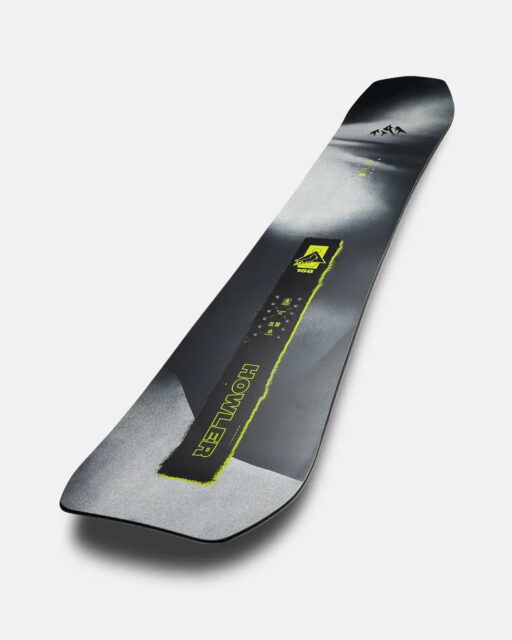
Shape
Designed with a fairly long nose, a bit of taper, and long sidecut, the Howler combines some directional, freeride-focused stability and edge hold with a little bit of the jibby feel that I might normally expect from a twin.
The Howler features Jones’ “medium 3D contour base,” which has a 4 mm spoon-shaped bevel along the nose and a varied 0-4 mm bevel along the tail. The spooned-out portion of the base starts just outward of the nose and tail contact points.
After riding several Jones boards with 3D bases over the years, I have grown to love how this convexity makes turning and carving feel just a touch more fluid and smooth, both on hardpack and in powder. The contoured shape seems to help the board roll from edge to edge more easily and intuitively, lending a surfy feel. Jones also claims that the 3D shaping in the nose reduces friction at the contact points and produces a faster glide. While I can’t attest to it resulting in a faster ride, I do really enjoy the edge-to-edge transitions it seems to deliver.
The Howler’s nose seems well designed for shallow and moderately deep powder; it’s long enough to provide respectable flotation, but not unwieldy when spinning / flipping or linking up features. The actual shovel of the nose is quite stiff and supportive (e.g., stiffer than the Weston Gnarnia, K2 Alchemist, and Head E.B.I. LYT). While some stiffer noses can ‘plow’ through soft snow rather than float above it, that hasn’t been the case with the Howler. And, paired with its similarly stiff tail, the Howler’s overall stiffness adds stability when stomping landings and riding fast through rough conditions.
While the Howler’s tail is pretty strong, its minimalistic fish-tail shaping slightly decreases its overall volume, which is appreciated on deep powder landings and also helps to reduce back leg fatigue on deeper days. Although many aspects of the Howler put it on the stiffer, more stable end of the spectrum, its shape does feel quite nimble when you want it to be.
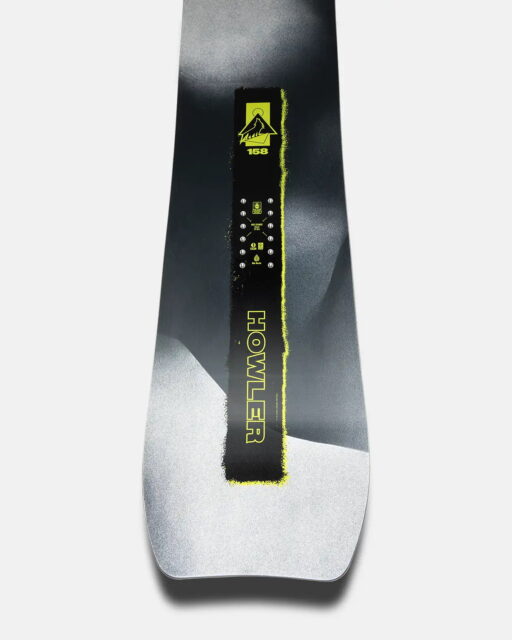
The Howler’s minimal taper, 8.6 m sidecut, and mostly cambered profile give the Howler impressive pop and edge authority on groomers and in powder. Some of the more directional shapes out there (e.g., Nitro Squash and Head E.B.I. LYT) are more exciting when carving up groomers, but the Howler still edges well in a variety of conditions.
Overall, the Howler shape makes for a very versatile option that spans the gap between directional twins and more powder-focused freeriding shapes. While we’ve seen plenty of highly specific shapes hit the market lately, the Howler stands out as a solid all-rounder.
Rocker / Camber Profile
The Howler features Jones’ “High Power Camber” profile. Most of the board is cambered, maxing out at 8 mm of camber toward the tail to deliver extra support in the back half of the board. That said, there’s a bit of rocker in the nose, and it does a great job helping with flotation on deeper days but resists chattering in firmer conditions. The subtle rocker in the tail starts well aft of the rear binding, providing impressive tail stability, but an abrupt ‘kick’ begins in the last 15 cm of the tail and rises to 4.5 cm of tail splay. The result is a long, supportive tail that can still ride switch in deeper snow.
Jones quotes Victor De Le Rue as saying that “the Howler is truly my perfect board. I can trust it in any terrain because it’s super stable for riding fast and the tail is amazing for landing big tricks.” I agree with Victor when it comes to how well the rocker / camber profile blends stability with an especially supportive tail for landings.
Flex Pattern
Jones rates the flex of the Howler as a 4 out of 5, which feels consistent both within the Jones lineup and among other companies’ stated ratings.
Although it is on the stiffer side, the Howler still provides a fairly smooth ride and remains easy to pop and throw around. The stiffer flex is well matched for the board’s intention of being a hard-charging Freeride deck that needs to handle both choppy conditions and sizable airs.
For how stiff the spine of the board is fore and aft, the Howler’s torsional flex is fairly user-friendly at slower speeds for tight maneuvering. For reference, I was only able to test the 160W, whereas a regular 160 cm would likely be more appropriate for my size 9 boot. Despite the ~1 cm wider waist of the Wide, the 160W Howler remained quite agile at slower speeds in tight trees and terrain, which seems partially down to its torsional flex not being wildly stout. This was also helpful when spinning off bumpy natural lips and features.
How does the Howler’s overall flex compare to similar shapes we have tested? Well, it’s significantly stiffer than the Head E.B.I. LYT (rated at 6/10); compared to the Arbor Iguchi Pro Camber (7/10) and Weston Gnarnia (8/10), the Howler feels comparable but a tad stiff. And the Howler feels a bit softer and more lively overall than the Jones Mountain Twin Pro (9/10) and K2 Alchemist (9/10).
In sum, the Howler is a great example of a mid-stiff board that leans toward the stable side, which helps add confidence when conditions are variable and speeds are high, yet it still provides powerful pop.
FULL REVIEW
Powder
The directional shape, floaty nose, and subtle fish tail of the Jones Howler make it a decent board for most powder days.
Obviously, there are floatier powder-specific shapes for making the most of deeper days (12’’+), such as the Jones Storm Chaser, Weston Japow, Amplid Snowmellier, or United Shapes Deep Reach. Compared to the Howler, those more dramatically tapered directional shapes with longer noses and shorter tails make for an easy, surfy ride in deep snow. But that is not what the Howler is intended for. It is built to be a Freeride shape that’s happy to hit and stomp big jumps and features, best exemplified by Xavier De Le Rue and Elena Hight’s riding styles. Still, the Howler provided enough float for most of my powder days at Alyeska Resort, though it’s worth reiterating that I’ve been testing a 160W, rather than a standard-width size like I’d typically ride.
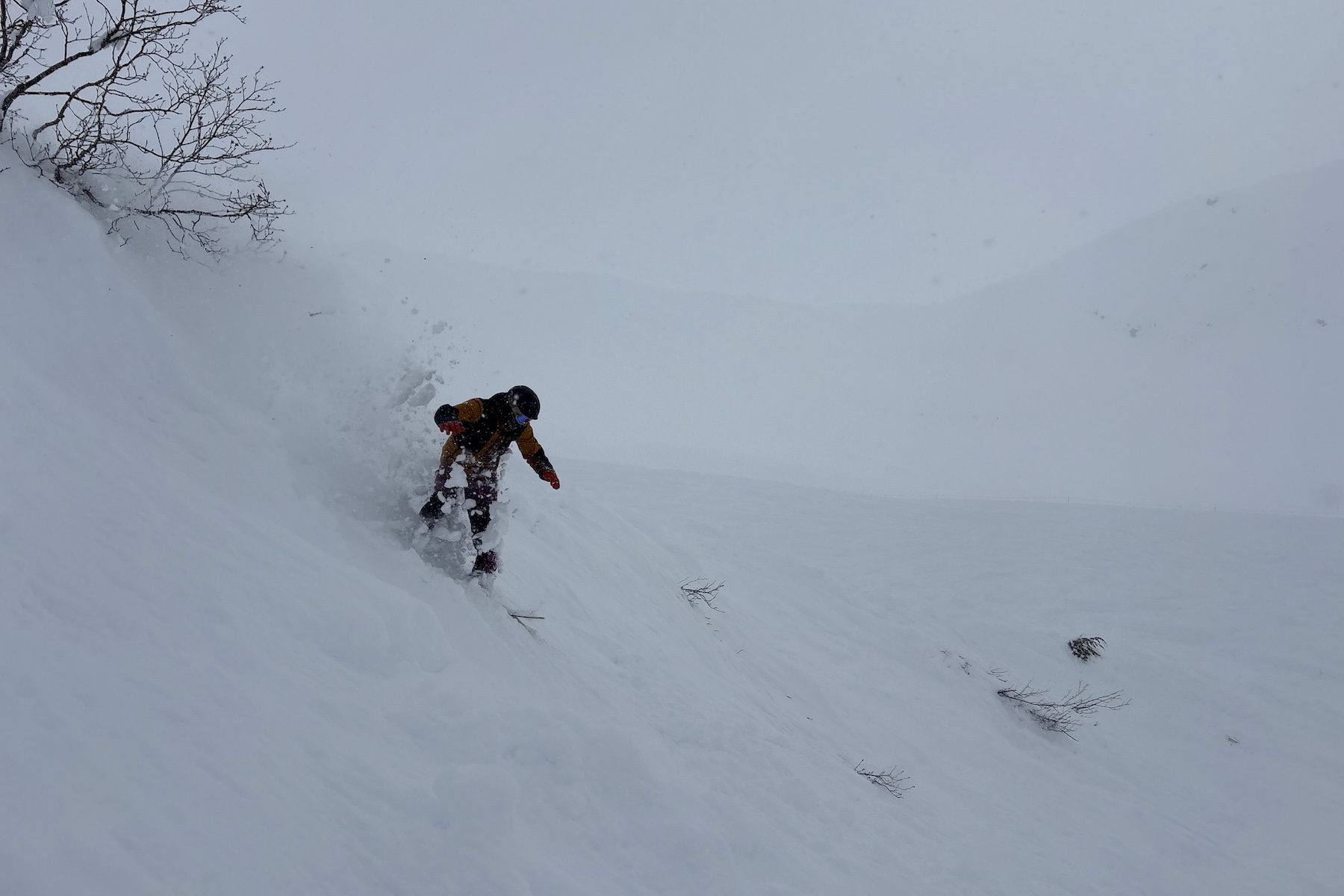
At least for me, the Howler really shines later in the day once things get tracked, the powder froth dies down, and a more creative approach to riding arises. For more Freestyle-oriented riders, though, the Howler’s energetic handling might be perfect on the first chair. Its stiff-yet-snappy nature lends itself well to popping off sidehits and drops, and its stiffer nose and tail feel especially stable and grounded on landings. I was pretty impressed with what I could get away with when accidentally landing flat in deep powder. In these instances, I was prepared to go over the nose due to miscalculations in especially wet, heavy snow, but I was surprised to ride out smoothly (ish) thanks to the Howler’s pretty stiff but damp-feeling flex.
Of the comparable boards we’ve tested over the seasons, I’d label the Howler as one of the more dialed soft-snow-focused options that still provides a lot of Freestyle capability. The Nitro Squash and Head E.B.I. LYT both feel more powder- and carving-oriented, at the cost of balance and stability, especially in bigger terrain and rougher conditions. The Howler generally floats and maneuvers better in powder than the more Freestyle-focused Arbor Iguchi Pro Camber, Jones Mountain Twin, and Weston Gnarnia. The K2 Alchemist offers similar powder performance to the Howler, but the Alchemist feels stiffer and less jib-friendly.

Soft Chop
As I alluded to above, the Howler’s stiff, snappy flex and directional shape make it a great soft-chop board, especially at higher speeds, but it’s surprisingly approachable for casual cruising. While its fore-aft flex pattern is on the stiffer side, the Howler still feels quite agile and easy to throw around in choppy and bumpy terrain. It handles chop far better than the softer-shoveled Head E.B.I. LYT and feels more akin to the K2 Alchemist and Nitro Squash. At the same time, the Howler is ideal for getting creative and sending features once things get tracked out — it feels stable and controllable, both while coming in hot on sketchy in-runs and when it comes time to put down the landing gear and ride through tracks and bomb holes.
Crud and Variable Snow
The Howler is a solid performer when it comes to dealing with crud and variable snow conditions. Most of that comes down to how composed it feels when running over less desirable snow, rather than it offering class-leading edge precision.
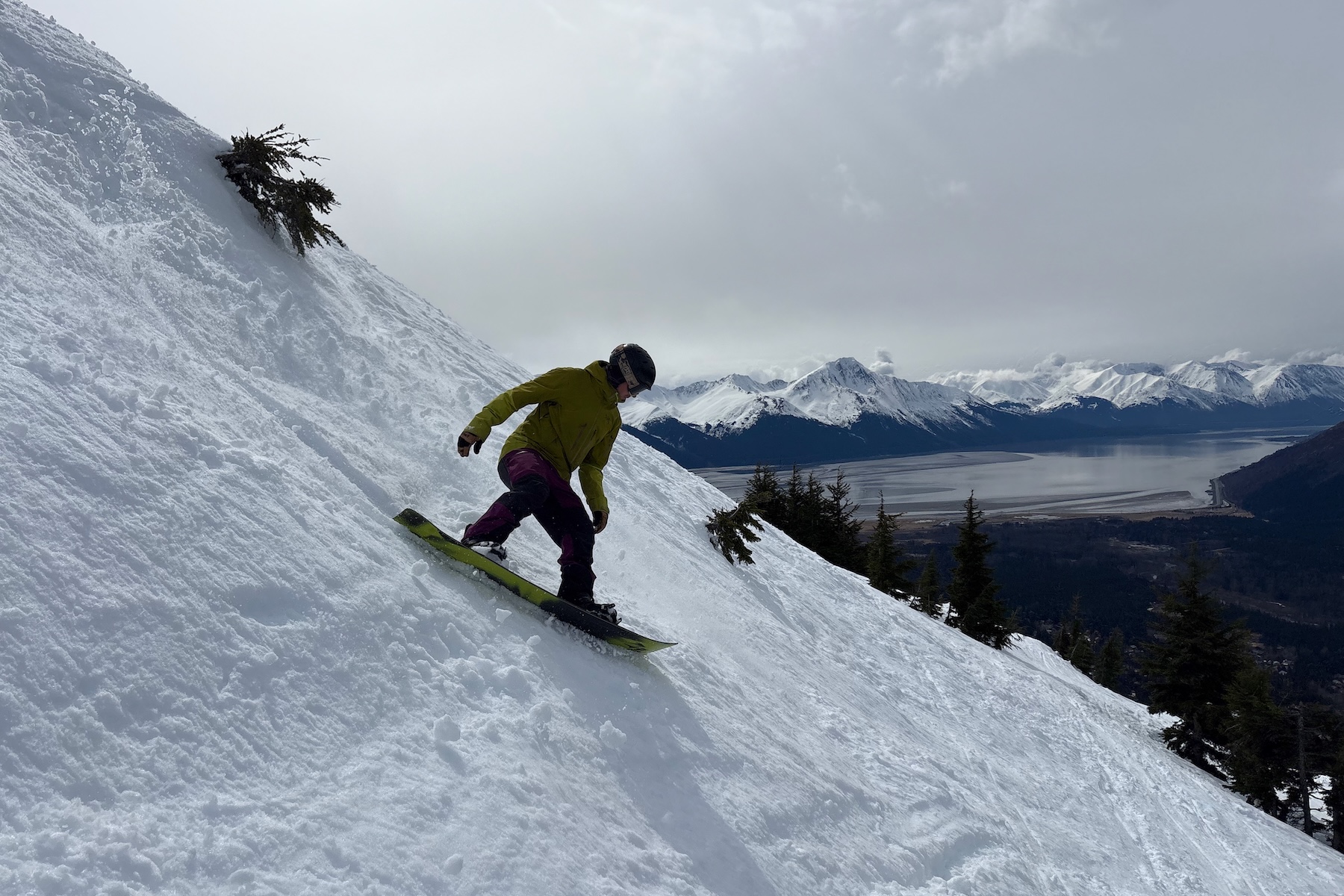
The Howler’s edge hold is adequate in most conditions, and its “Traction Tech” edge profile (subtle ‘serrations’ in the sidecut) helps reduce the chance of fully washing out. Still, when things are super firm / icy, I have an easier time trusting the grip of several other, more carving-focused boards, such as the Head E.B.I. LYT, Nitro Squash, or Arbor Iguchi Pro.
Granted, I’ve been riding the 160W Howler, instead of a regular-width 158 cm or 161 cm length, which would be better suited for my size 9 boot. But at least for the 160W Howler, it didn’t provide as much edge power on hardpack and groomers as I would personally prefer.
We’ll update this if we test a regular-width version and notice a significant difference. For now, I’d say the Howler shines in a wide range of “3D” snow conditions, but it wouldn’t be my top pick for the firmest, smoothest snow. While it doesn’t have the locked-in edge hold of some other boards, the Howler does remain fairly forgiving and does not seem prone to unexpectedly hooking edges.

Groomers
The Howler handles groomers predictably, whether bombing hills, casually cruising, or taking laps through the park, but I wouldn’t say it’s a super exciting, standout carver.
Again, potentially due to the width of the 160W I tested, I had a hard time getting the Howler to ‘lock in’ when laying over the board on edge. The Head E.B.I. LYT and Nitro Squash both stand out as being much easier to lay over and properly dig into the snow when trying to really lay trenches on groomers (worth noting: the 161 cm E.B.I. LYT is even wider than the 160W Howler).
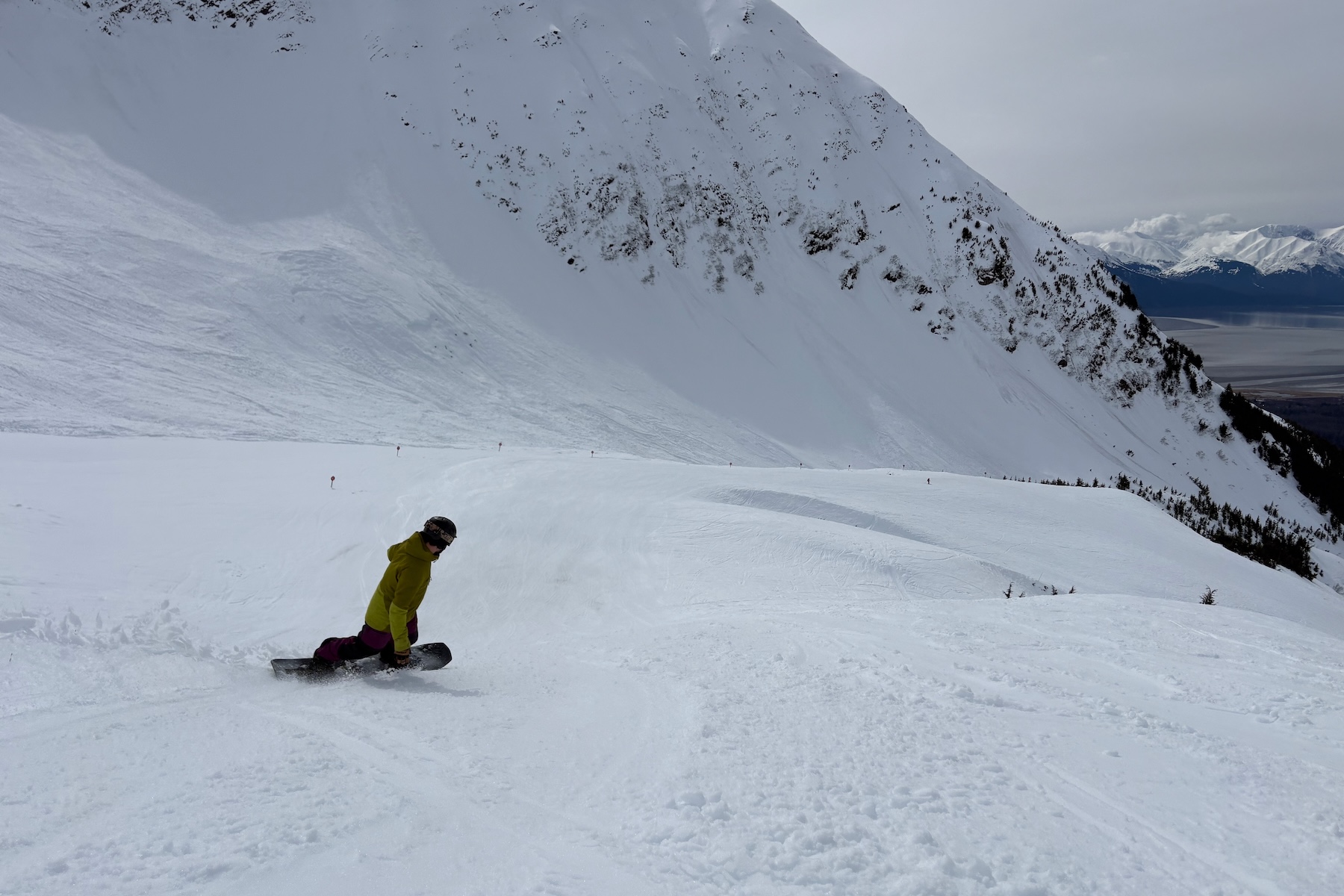
The Howler wouldn’t be my top choice for someone who really prioritizes carving performance, but I still found it to be a playful companion on groomers. Its substantial pop and supportive tail feel right at home lapping the park or searching out side hits, natural jumps, and features intermixed across groomed runs.
Who’s It For?
The Howler should be on the radar of intermediate to expert-level riders seeking a stable, supportive, and versatile board that blends Freeride and Freestyle traits.
The Howler excels in powder and thrives in big terrain, but can still cruise around the mountain without feeling boring or punishing. The Howler’s consistency across multiple snow and terrain types really helps it stand out, and its composure at high speeds and on big landings makes it an especially apt choice for folks looking to stomp big lines.
There are faster and floatier pow shapes out there, softer alternatives for slower-speed jibbing, and more precise and powerful carvers. However, the Howler does a great job of combining all-mountain versatility with high-speed composure — all without seriously compromising pop and Freestyle performance.
While we always recommend taking sponsored athletes’ endorsements with a hefty grain of salt, I happen to very much agree with Xavier De Le Rue’s description of the Howler: “The goal for the Howler was to make a Freeride board that had the power to stomp harder and spin faster. This is a board for riders who want to test their Freestyle skills in steep terrain.”
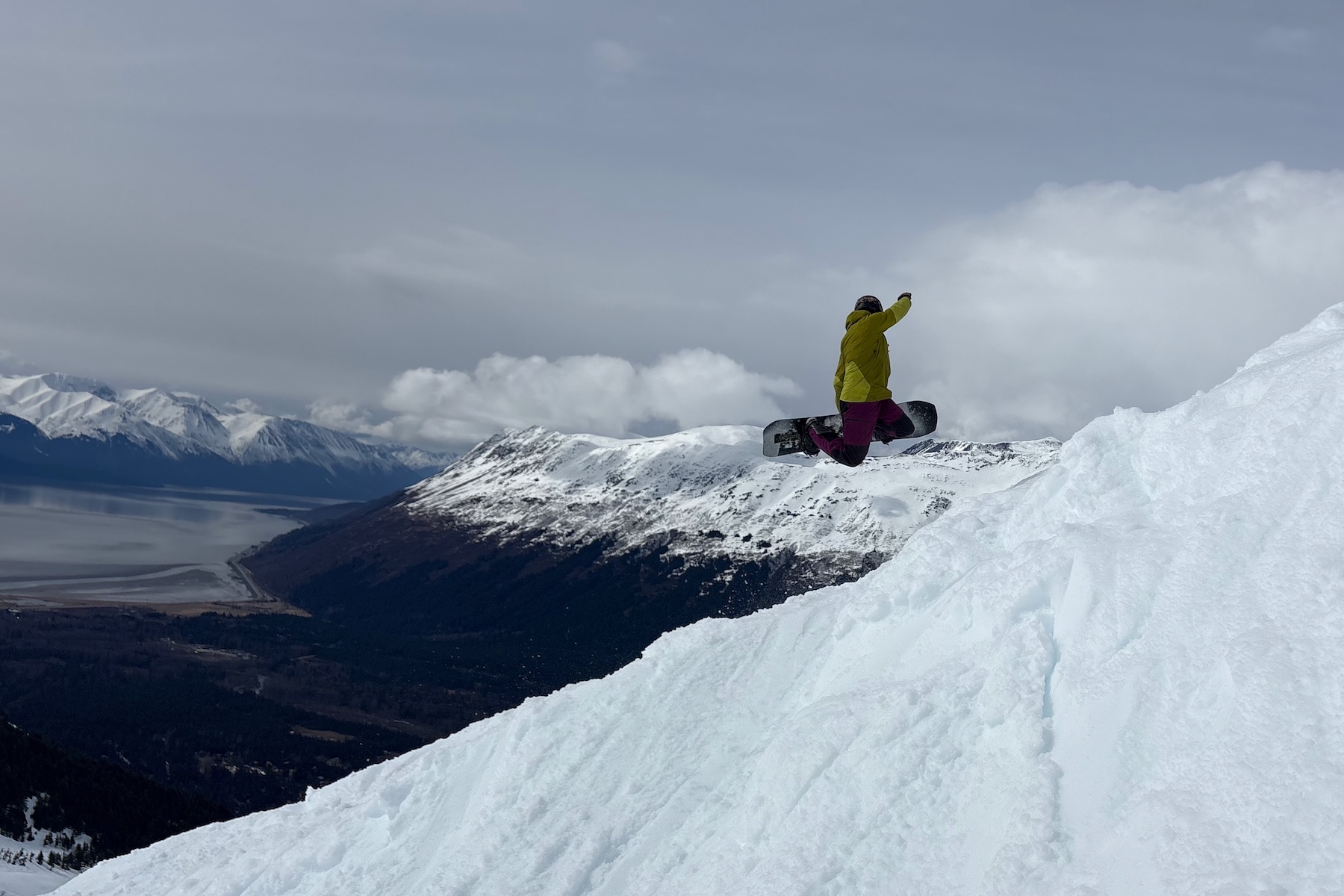
Bottom Line
The Jones Howler is a fantastic shape for everyday riding that pairs impressive, Freeride-friendly stability with a stiff-yet-poppy flex pattern that also caters to a Freestyle-focused approach. While it is a high-end board aimed at more experienced riders, the Howler is still fairly user-friendly and easy to throw around.
The Howler would be a great 1-board quiver option for those looking for something that feels especially stable across a variety of snow conditions and terrain types, but remains playful and feels at home hitting jumps and drops. The Howler could also be a great addition to a larger quiver, potentially slotting in between a truly powder-specific shape and a more piste-focused board.
For folks who like to bring Freestyle riding into bigger Freeride terrain, the Howler deserves a close look.

